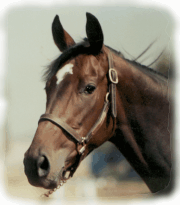
Don Blazer
Archives:
Flying Horses?
Don't eat like a Pig
Parasites
Back Sore?
Goat Hero
Communication
Foals
History of Horses
Jumping Horses
Lameness and Health
Kick the IRS
Books by Don Blazer
Order using our Secure Order Form

Walter (A Horse, of Course) Spills the Oats

Nine Secrets of Perfect Horsemanship
Secure Book Order Form
This is a Secure Web Site

Don Blazer
A Horse, Of Course
Archives:
Flying Horses?
Don't eat like a Pig
Parasites
Back Sore?
Goat Hero
Communication
Foals
History of Horses
Jumping Horses
Lameness and Health
Kick the IRS
Books by Don Blazer
Order using our Secure Order Form
View Our Catalog
Secure Book Order Form
This is a Secure Web Site

|
A little more than 10 thousand years ago--give or take a 1,000 years--one cave man said to another, I'm so hungry I could eat a horse.
So they did.
First man just ate the horse. Later he discovered he could keep lame mares and milk them. That was the beginning of the meat and milk industry.
Man’s progress wasn’t too swift until he got on the horse’s back, then the whole human race began to boogie.
Exactly when man domesticated the riding horse is questionable. Which of the many human societies first utilized the horse as a mount is debatable. But the fact progress went from a walk to a gallop once man and horse became partners is undeniable.
A good theory is the earliest riders were the Brahmans of India.
Hindu mythology had its first human--known variously as Manu, Sveyambhuva or Viraj--mounted on a horse. Since Manu as the example by which all faithful Hindus were to live, it’s logical to assume equitation was highly prized and already well advanced.
If the Brahmans were the first to master equitation, they were not lone riders long. Riding astride was soon learned wherever horses were found--Asia, North Africa and Europe. We know the Chinese, Assyrians and Persians were skilled riders 3,000 years before Christ.
Even if the Brahmans were the first "riders," there is no doubt the Chinese were the first real "horsemen." The Chinese were harnessing the horse about 4,000 BC There is great evidence to support the idea the Chinese used the horse earlier, to a greater extent and in more ways than did any other civilization. The Chinese were involved in selective breeding and selective conformation (having several different kinds of horses for different jobs) as early as 1,000 years BC
About 2,000 BC the Hittites over in the Mediterranean were doing their thing with the horse. They were using the horse for war, and they were winning. And the Hittites had it together, for it was the Hittites who left the first text on the care and rearing of horses. The document was written about 1,600 BC and contains some advice about the training of a horse which is as applicable today as it was then.
For example, the Hittites said a horse needed the equivalent of about 100 miles of gallops before being asked for real speed. Most trainers today will agree the modern Thoroughbred needs about 100 miles of gallops before being asked to show some of his speed.
The Assyrians were the first of the eastern Mediterranean cultures to make use of an article resembling a saddle. All they lacked was a stirrup, but at the time, so did everyone else.
The Egyptians were also using the horse about 1,650 BC as a mean of expanding their empire. Curiously, they had no interest in riding astride, preferring the chariot. Maybe they didn’t ride because their horses at the time where not much like the Arabian of today.
The horse entered western culture much the same as so many other phenomena--through mythology.
The Greeks believed the horse came from the sea, a creation of the water god, Poseidon. Perhaps the story stems from an assault by a fleet of ships which carried cavalrymen who rode their horses ashore and easily defeated the defenders of Crete about 2,000 BC
Could the centaur, half-horse, half-man, have been the description given a conquering cavalryman seen for the first time? And once victorious, could that "centaur" have carried off women providing the evidence of the power and lust of the centaurs?
The winged-horse, Pegasus, also appears in Greek mythology as Poseidon’s means of disclosing sources of fresh water to man.
We know the wild horse will paw the dry earth at a point he instinctively or empirically knows to be a water hole. Was it this action the stories relate as Poseidon’s gift?
The horse in Greek mythology is pretty well known, but is not without parallel. The Chinese had their own version of the centaur--the Ting-Ling, wisest of all beings, and, of course, half-man, half-horse.
Yep, the horse got things going for man, once they became partners. And during the early partnership, the horse was always associated with wisdom, power and utility.
Why mess with a good thing?
Each month you'll find a new column on our web site. We hope you'll enjoy it, and maybe e-mail us with questions or suggestions for other columns. A Horse, Of Course is a weekly column syndicated by Success Is Easy. If you like the column, call your local newspaper, or local horse publication and ask them to subscribe by contacting Success Is Easy, 13610 N. Scottsdale Rd., Suite 10-406, Scottsdale, AZ 85254
________________________________
A Horse Of Course |
Horse Books Catalog |
Meet Don Blazer
Ask Don Blazer |
Courses and Clinics |
Horse Training
Horses for Sale |
Who's Walter? |
Horse Links
Home
Info@donblazer.com
Copyright © 2000 by
Don Blazer
Success Is Easy, 13610 N. Scottsdale Rd., Suite 10-406, Scottsdale, AZ 85254
Vanndal Web Designs


